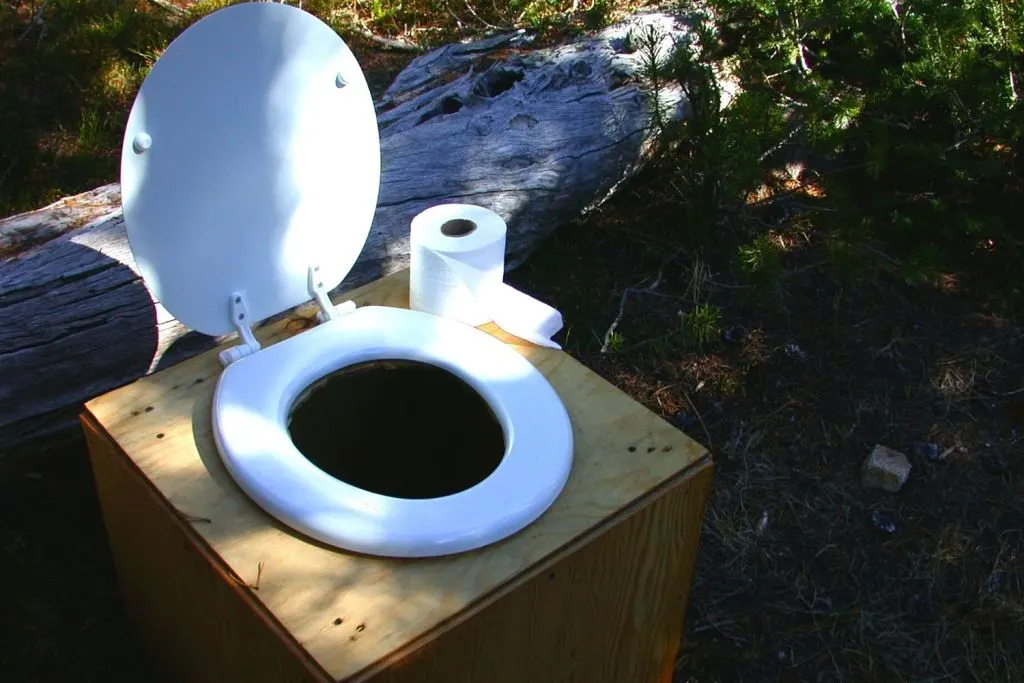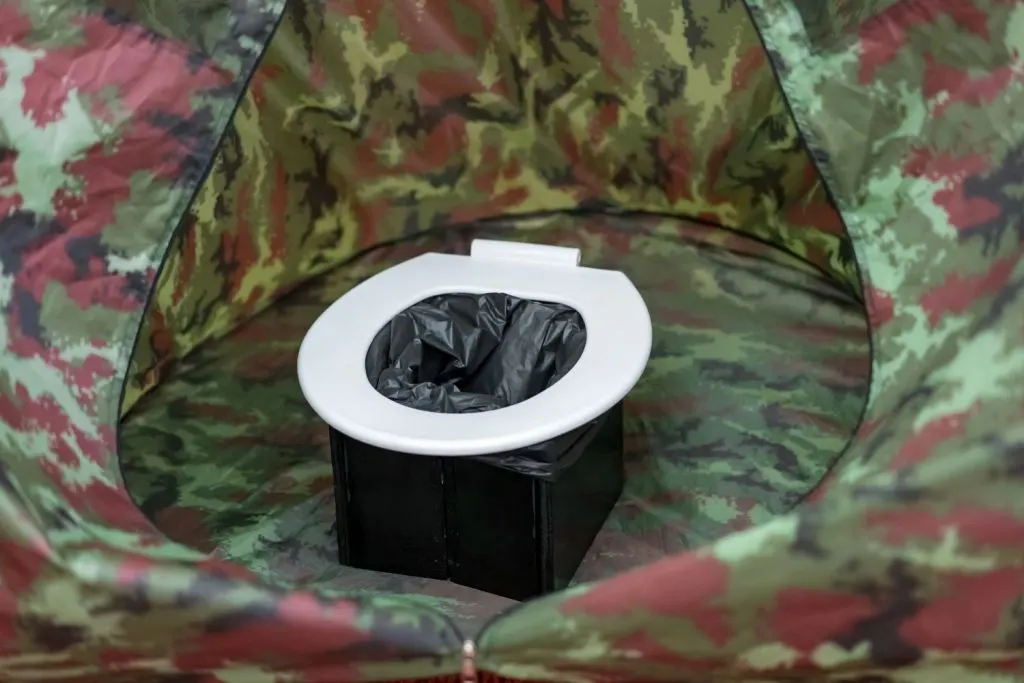How to Make a DIY Camping Toilet
Camping is awesome, but not all campground bathrooms are. A DIY camping toilet eliminates the need to use public or vault toilets and can be especially useful when in an area with no facilities.
Here, we cover the two main types of DIY camping toilets and how you can make them yourself, on the cheap!

What is a DIY Camping Toilet?
Just how it sounds, a DIY camping toilet is a toilet for camping that you make yourself! You can make a DIY camping toilet out of common, easy to find materials. Chances are, you already have these materials on hand.
Benefits of Making Your Own Camping Toilet
There are so many benefits to making your own camping toilet. For one, it can be really cheap! You can make a DIY camping toilet for $10 or less.
Another benefit is never having to use nasty vault toilets or porta-potties ever again. Or, never having to dig a cathole in the woods. Also, never having to head out in the dark to do your business. The list can go on and on!
What it comes down to is that having your own toilet makes you self-sufficient, it’s convenient, and they’re really easy to make.

Two Options for DIY Camping Toilets: Separating or All-in-One
When it comes to making a DIY camping toilet – you have a few options. The most popular and easy options are either a separating toilet or an all-in-one camping toilet. Let’s dive into the differences between these two types of toilets.
Separating aka Composting Toilet
Another name for a separating toilet is composting toilet. These toilets work by separating liquid waste and solid waste into separate containers.
Separating the two types of waste eliminates odors, and the waste is generally easier to deal with.
Solid waste goes into a container with a composting medium in it. Composting medium can be many types of organic material. Popular mediums are sawdust, peat moss, or coco coir – which is shredded coconut husks.
The solid waste is emptied into a garbage bag and can be disposed of like regular garbage. Alternatively, it can be buried, depending on the rules and regulations where you are camping.
Liquid waste is diverted into a different container, like a gallon jug. This jug can be emptied in a regular toilet, vault toilet, or spread around on the ground depending on where you are camping.

Pros of Separating Toilets:
There is virtually no odor. Typically, the liquids smell worse than the solid waste. Disposing of the liquid and solid waste with these types of toilets is easy and can be done just about anywhere.
Also, the solids don’t have to be disposed of very often, depending on the size of your container. You could go 1-2 weeks (or longer) without disposing of solids.
Cons of Separating Toilets
Cons to separating toilets are that they cost more to make and require more materials. But, making a DIY separating toilet is way more cost efficient than buying one!
A new composting toilet costs around $1,000. You can make one yourself for under $200! Depending how you make it, you can bring costs down to under $100.
Another con is that the liquids will have to be emptied frequently depending on use. You can generally expect to empty the liquids every 1 or 2 days.
All-in-One Toilet
An all-in-one toilet is just what it sounds like. The liquids and solids all go into the same bin. These toilets are very convenient because of how low-cost they are to make.
With this kind of toilet, you would typically have a container lined with a garbage bag (or two), with medium inside to do your business. Popular mediums for all-in-one camping toilets are cat litter, sawdust, or wood pellets.

Pros of All-In-One Camping Toilets
These toilets are super cheap and easy to make – we’re talking under $10. You probably already have the supplies on hand. This is the perfect solution for a last-minute camping toilet.
Cons of All-In-One Toilets
The cons to these kinds of toilets are the smell – you’re putting both solid and liquid waste together. This creates sewage, which creates a noxious odor.
Sewage is also a biohazard, so emptying these toilets has to be handled with care.
Also, all-in-one toilets will have to be emptied frequently. You can expect to empty these toilets once every 1 or 2 days.
How to Make a DIY Camping Toilet from 5 Gallon Bucket
To make an all-in-one camping toilet, you only need a few things and a few minutes of time.
Supplies:
- 1 5-gallon bucket
- Garbage Bags
- Pool Noodle (Or toilet seat made for the bucket, you can find one here)
- Sawdust, Cat Litter, or Wood Pellets
Alternatively, get the Luggable Loo for about $20 on Amazon.
Steps:
Line your 5 gallon bucket with a garbage bag or two, and put your medium of choice in the bottom. You can add more medium as you use the toilet if needed, but make sure it never gets too heavy for the bag to handle.
Cut your pool noodle to size to fit around the rim. Cut it length-wise to fit over the rim of the bucket.
Voila! Your DIY camping toilet is ready to use.
Separating Camping Toilet
To make a separating camping toilet, you will need a few more supplies. Some, you’ll have to order online. Others you can find at your local hardware store.
Supplies:
- 5 Gallon Bucket
- Urine Diverter
- Gallon Jug
- Wood Box to Enclose It All
- Composting Medium: Peat Moss, Coco Coir, or Sawdust
- Toilet Seat
- Possible: tubing for draining liquids into jug
- Garbage Bags
Steps:
With this toilet, your gallon jug will usually sit in front of your 5 gallon bucket. Build a box big enough to accommodate this, with a toilet seat on top.
Place your bucket and jug in your toilet box. Then, install your urine diverter either by affixing it to the underside of the box lid, or to your 5 gallon bucket.
If necessary, install tubing on underside of urine diverter to reach your liquids container.
Line 5-gallon bucket with a garbage bag, and sprinkle some composting medium in the bottom. Every time you use the solids container, you will add more composting medium on top.
Close the lid and you’re done!
DIY Camping Toilets Make Camping Easier
If you’re camping somewhere without a toilet or you just prefer the convenience and privacy of being self-contained, a DIY toilet is a game changer.
Both options are great, but we definitely recommend a separating or composting toilet for long trips or if you camp super frequently!
Discover the Best Free Camping Across the USA
To be honest with you, we hate paying for camping. There are so many free campsites in America (with complete privacy).
You should give it a try!
As a matter of fact, these free campsites are yours. Every time you pay federal taxes, you’re contributing to these lands.
Become a FREE CAMPING INSIDER and join the 100,000 campers who love to score the best site!
We’ll send you the 50 Best Free Campsites in the USA (one per state). Access the list by submitting your email below:
In scouts we built a toilet using split wood, stripped the bark off for the seat and three other piece lashed together and placed over a hole! We put this away from the sleeping and eating area, and hung tarps over some branches. We also had a spade to cover the refuse w/dirt!